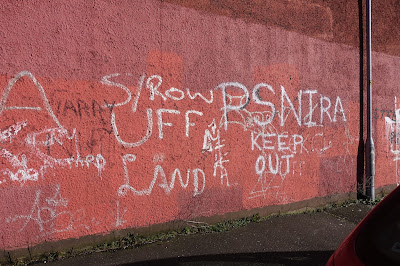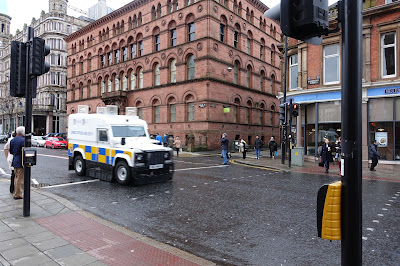The second you walk into either of these areas you'll notice their clear allegiances to the Unionist cause. Not only are Union flags or Ulster Banners hanging from the top of almost every lamppost, but the curbstones on the streets and the bottom of the lampposts are painted red, white, and blue; the colours of the British Flag.
Another thing that catches the eye is the amount of graffiti sprayed on the walls. I mentioned earlier that graffiti seems to be a norm in Belfast, but unlike in the city centre, much of the graffiti in these two neighbourhoods is related to the U.D.A or U.V.F; both Loyalist paramilitary organizations which have been active in Northern Ireland from the beginning of The Troubles. I even saw a well kept memorial to U.D.A fighters who had been killed during the Troubles among some of the houses in Sandy Row, which might show that there is still sympathy towards these groups. However, even with all this material that seems to support the paramilitaries, there was a huge mural in "The Village" which expressed its support for the peace process in the 1990s.
I've not had a chance to speak with anyone in these areas about my topic yet, but they seemed friendly and I hope to interview some in the coming days. I noticed the office of a local Ulster Unionist Party politician in Sandy Row, and I will go in to see if he'll be willing to talk to me about how The Troubles has influenced his constituency. One of the things I need to find out is if the graffiti is new or if it's still left over from The Troubles, because obviously if it is new then that would show that members of the community still support the paramilitaries, but if it's old then it may not be a symbol of support but a relic of the past.
Union Flag in Sandy Row
Houses in Sandy Row
Union Flag on Donegall Road
Painted Curbs on Donegall Road
Painted Lamppost in Sandy Row
Another thing that catches the eye is the amount of graffiti sprayed on the walls. I mentioned earlier that graffiti seems to be a norm in Belfast, but unlike in the city centre, much of the graffiti in these two neighbourhoods is related to the U.D.A or U.V.F; both Loyalist paramilitary organizations which have been active in Northern Ireland from the beginning of The Troubles. I even saw a well kept memorial to U.D.A fighters who had been killed during the Troubles among some of the houses in Sandy Row, which might show that there is still sympathy towards these groups. However, even with all this material that seems to support the paramilitaries, there was a huge mural in "The Village" which expressed its support for the peace process in the 1990s.
U.D.A Graffiti in Sandy Row
Anti-Police Graffiti in Sandy Row
U.D.A Mural in Sandy Row
U.D.A Mural in Sandy Row
U.D.A Memorial in Sandy Row
Pro-Peace Memorial on Donegall Road
U.V.F Artwork on Donegall Road, Opposite the Peace Mural
I've not had a chance to speak with anyone in these areas about my topic yet, but they seemed friendly and I hope to interview some in the coming days. I noticed the office of a local Ulster Unionist Party politician in Sandy Row, and I will go in to see if he'll be willing to talk to me about how The Troubles has influenced his constituency. One of the things I need to find out is if the graffiti is new or if it's still left over from The Troubles, because obviously if it is new then that would show that members of the community still support the paramilitaries, but if it's old then it may not be a symbol of support but a relic of the past.
U.D.A Graffiti on Donegall Road
Anti-Republican Graffiti in Sandy Row
Sandy Row and the Donegall Road don't only have murals related to The Troubles, and it would be dishonest for me to act as if the only murals in these neigbourhoods are ones about the Troubles. Belfast had the world's largest shipyard at the beginning of the 20th century, and many of the great ocean liners of the time were built by men coming out of areas like Sandy Row. Another pivotal moment in the history of Northern Ireland was the Battle of the Somme during the First World War. The 36th Ulster Division took very heavy casualties in the battle, which is approaching its 100th anniversary this year. Both of these events are commemorated with huge murals in "The Village."
So far I've only been able to visit Protestant neighbourhoods in Belfast, but this is a trend that will not last. I will head out to the Catholic neighbourhoods as soon as possible, so that I can give you all an introduction to the Republican side. The first of my promised interviews are in the works, and I should be able to give you some of them soon.
Till next time!
-Luke van Reede van Oudtshoorn
Mural to the Battle of the Somme, on Donegall Road
So far I've only been able to visit Protestant neighbourhoods in Belfast, but this is a trend that will not last. I will head out to the Catholic neighbourhoods as soon as possible, so that I can give you all an introduction to the Republican side. The first of my promised interviews are in the works, and I should be able to give you some of them soon.
Till next time!
-Luke van Reede van Oudtshoorn





























